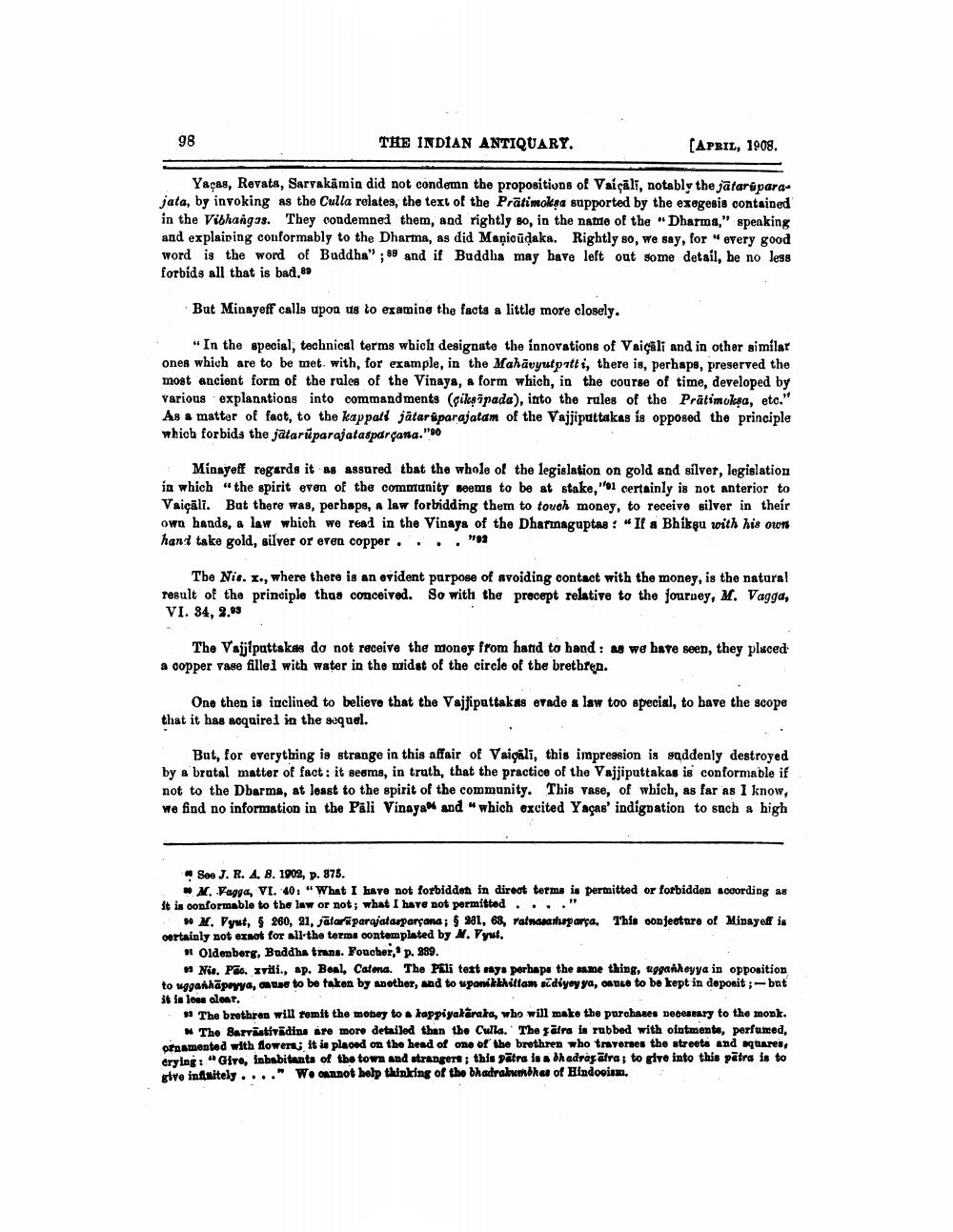________________
98
THE INDIAN ANTIQUARY.
[APRIL, 1908.
Yaças, Revata, Sarvakāmin did not condemn the propositions of Vaíçali, notably the jataruparajata, by invoking as the Culla relates, the text of the Pratimoksa supported by the exegesis contained in the Vibhangas. They condemned them, and rightly so, in the name of the "Dharma," speaking and explaining conformably to the Dharma, as did Manicuḍaka. Rightly so, we say, for "every good word is the word of Buddha"; 88 and if Buddha may have left out some detail, he no less forbids all that is bad,89
But Minayeff calls upon us to examine the facts a little more closely.
"In the special, technical terms which designate the innovations of Vaiçali and in other similar ones which are to be met. with, for example, in the Mahāvyutpatti, there is, perhaps, preserved the most ancient form of the rules of the Vinaya, a form which, in the course of time, developed by various explanations into commandments (çikṣapada), into the rules of the Pratimukṣa, etc." As a matter of fact, to the kappati jätaruparajatam of the Vajjiputtakas is opposed the principle which forbids the jataruparajatasparçana."90
Minayeff regards it as assured that the whole of the legislation on gold and silver, legislation in which "the spirit even of the community seems to be at stake, "01 certainly is not anterior to Vaicāli. But there was, perhaps, a law forbidding them to touch money, to receive silver in their own hands, a law which we read in the Vinaya of the Dharinaguptas: "If a Bhiksu with his own hand take gold, silver or even copper.... "92
The Nis. x., where there is an evident purpose of avoiding contact with the money, is the natural result of the principle thus conceived. So with the precept relative to the journey, M. Vagga, VI. 34, 2.95
The Vajjiputtakas do not receive the money from hand to hand: as we have seen, they placed a copper vase filled with water in the midst of the circle of the brethren.
One then is inclined to believe that the Vajjiputtakas evade a law too special, to have the scope that it has acquired in the sequel.
But, for everything is strange in this affair of Vaigali, this impression is suddenly destroyed by a brutal matter of fact: it seems, in truth, that the practice of the Vajjiputtakas is conformable if not to the Dharma, at least to the spirit of the community. This vase, of which, as far as I know, we find no information in the Pali Vinaya and "which excited Yaças' indignation to such a high
See J. R. A. 8. 1902, p. 875.
M. Vagga, VI. 40: "What I have not forbidden in direct terms is permitted or forbidden according as it is conformable to the law or not; what I have not permitted. . . ."
90 M. Vyut, § 260, 21, jataruparajatasparçana; § 281, 68, ratnasamsparça. This conjecture of Minayeff is certainly not exnot for all the terms contemplated by M. Vyut.
Oldenberg, Buddha trans. Foucher, p. 289.
Nis. Pao. xvili., ap. Beal, Catena. The Pali text says perhaps the same thing, ugganheyya in opposition to ugganhapeyya, cause to be taken by another, and to upanikkhittam sadiyey ya, cause to be kept in deposit ;-bat it is less clear.
"The brethren will remit the money to a kappiyakaraka, who will make the purchases necessary to the monk. The Sarvästivadins are more detailed than the Culla. The fatra is rubbed with ointments, perfumed, ornamented with flowers; it is placed on the head of one of the brethren who traverses the streets and squares, erying: "Give, inhabitants of the town and strangers; this patra is a bhadray atra; to give into this patra is to give infinitely. "We cannot help thinking of the bhadrakumbhas of Hindoeism.




